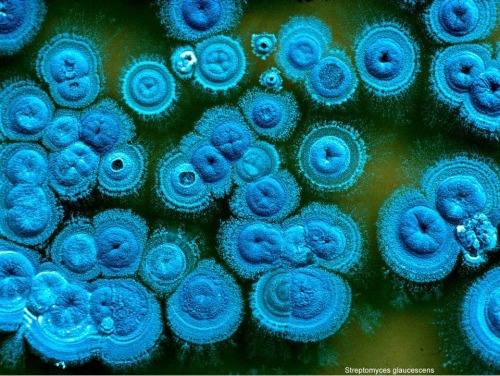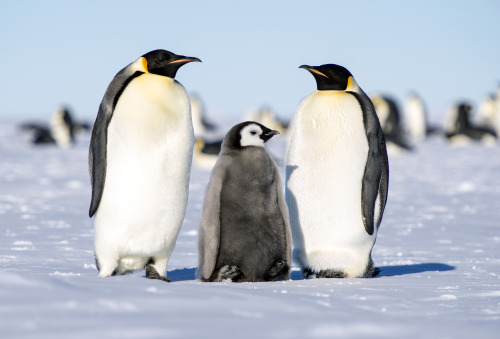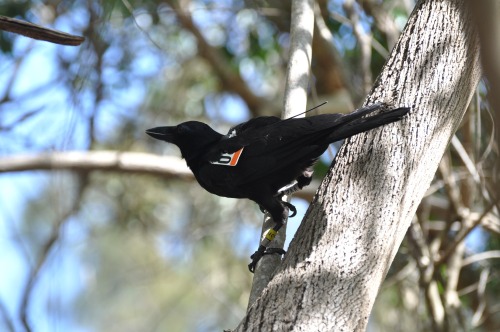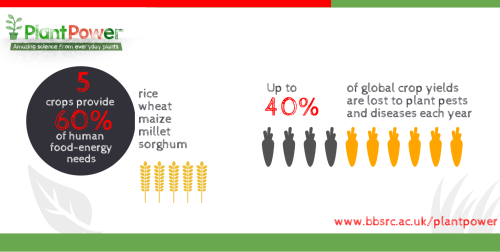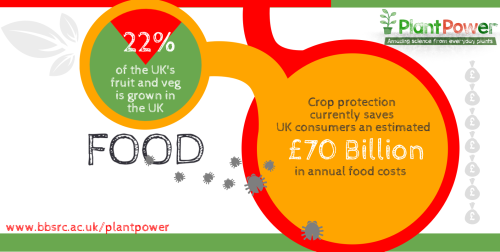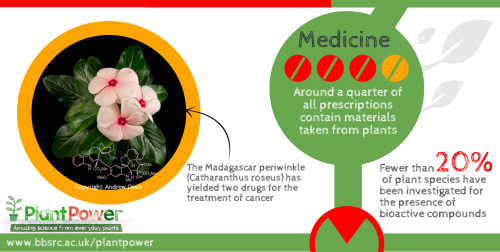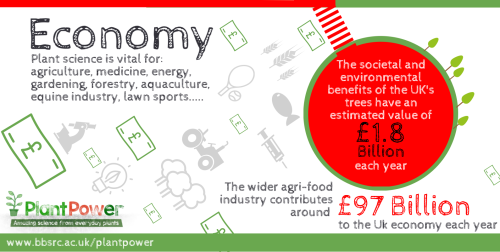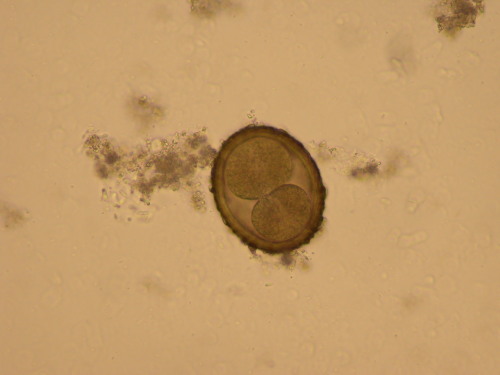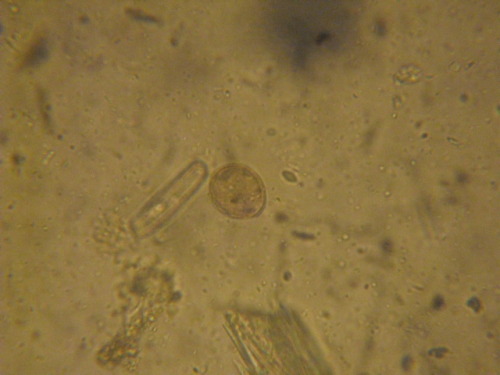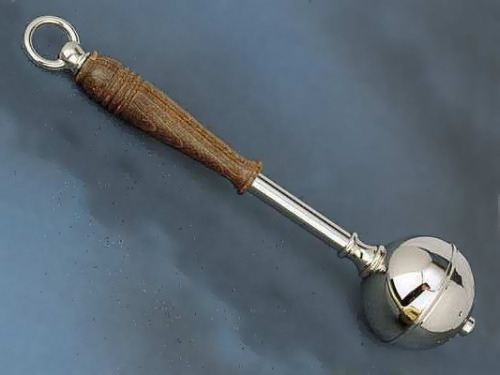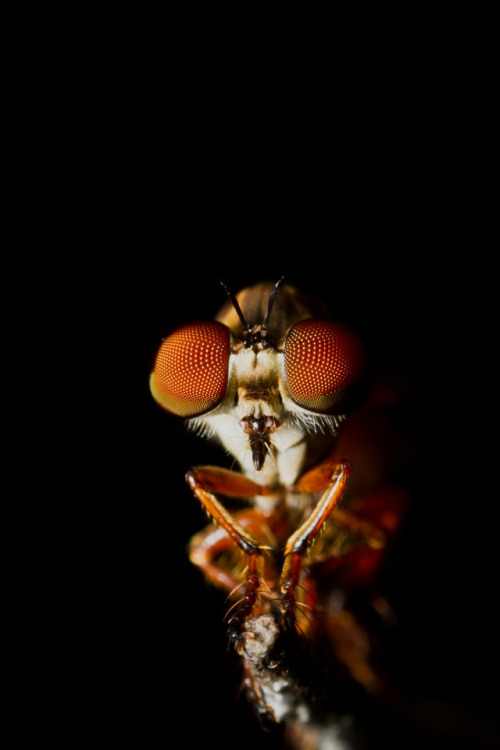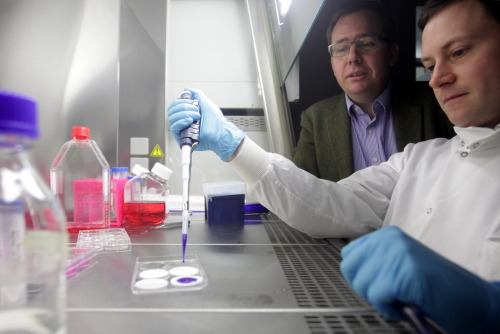#bioscience
Antibiotic hunters
Bacteria known as Streptomyces (see images above) are the source of the majority of important antibiotics used in medicine today. These drugs have revolutionised the treatment of infectious disease since their introduction into clinical practice in the 1940s.
Recently, the World Health Organisation has warned of a “post-antibiotic era”, where people could die from simple infections that have been treatable for decades. This is because some disease-causing bacteria have evolved to become resistant to most currently used antibiotics, for example MRSA.
BBSRC investment in Streptomyces research since the 1960s has had a huge impact on our understanding and development of antibiotics, and scientists at the BBSRC-funded John Innes Centre are among those now using this knowledge to help discover and develop the new antibiotics needed to counter the threat of antibiotic resistance.
If you want to find out more about this area of research make sure you get yourself along to the Great British Bioscience Festival exhibit showing at the Science in Norwich Day on the 1 of June.
Read more: http://www.bbsrc.ac.uk/research/impact/streptomyces-antibiotics.aspx
Top image and middle image copyright: David Hopwood and Andrew Davis
Bottom image of copyright:Tobias Kieser
Post link
Physical attraction is linked to heightgenes
Scientists have discovered that who you find attractive is partly down to the genes affecting your height.
In a study of more than 13,000 heterosexual couples they found that 89% of the genetic variation that controls a person’s height also influences their height preference in a partner.
Generally people are attracted to partners of similar heights to themselves.
Did you know that our choice in partners can have important consequences for human populations? This study brings us closer to understanding the complexity of sexual attraction and the mechanisms that drive variation in humans.
Images: Susana Fernandez, Boris SV
Post link
How peckish penguins find their food
Animals have used the same technique to search for food that’s in short supply for at least 50 million years, a BBSRC-funded study suggests.
Creatures including penguins search for food using a mathematical pattern of movement called a Lévy walk. It might sound complex, but it is a random search strategy made up of small steps and a few larger steps. Although a Lévy walk is random, it’s the most efficient way to find food when it’s scarce.
Finding food in a timely fashion could be a matter of life or death. Choose the wrong direction and it could be curtains. But moving in a random search pattern is mathematically the best way to find isolated food.
Image credit: Christopher Michel
Stay tuned for more (biological) festivities…
Post link
How crows connect
The New Caledonian crow is well-known for its ability to make and use tools to poke nutritious insects out of their hiding places.
An international team led by the University of St Andrews has studied the social networks of crows to understand how tool-use might spread between birds and across communities.
The team looked at the social interactions of wild New Caledonian crows in their tropical habitat. Each crow was fitted with a high-tech, miniature spy tag which provided a record of which crows met at any given time.
They found that providing the crows with food had a similar effect to putting out a plate of freshly baked cookies – individual crows hang around the supply which can accelerate the spread of interesting information.
Scientists still don’t know how much of their tool-use behaviour New Caledonian crows learn from each other, but the study shows that opportunities for information exchange are plenty, especially when important resources encourage birds to forage in the same place.
Images: James St Clair, James St Clair, Jolyon Troscianko
Post link
Plant power
Healthy plants, including crops and trees, are vital for our future. They are fundamental to our food, environment, economy and social wellbeing.
Plant scientists are finding new ways to solve some of our biggest challenges, such as protecting our forests, finding new fuel sources and ensuring that we have enough food for a growing population.
Did you know that ¼ of all medicines contain materials taken from plants?
Post link
How the world’s first plants took a giant leap on to land
About 450M years ago, plants in the sea took a giant leap on to land to become the plants we know and love today. But how did they survive?
Scientists for The John Innes Centre may have found the answer.
Land plants survive by getting water and nutrients from soil.
They do this by forming a special friendship with soil dwelling fungi called mycorrhiza. These strands of fungi reach deep into the spoil and drag the nutrients and water back to the plants.
But when the first algae landed on soil, how did they survive long enough to form these beneficial friendships?
New research suggests that they already had the genes necessary for forming this bond whilst they lived in the sea.
Researchers analyzed DNA and RNA of some of the earliest known land plants and green algae and found evidence that their shared algal ancestors living in the Earth’s waters already possessed the necessary set of genes needed to detect and interact with the beneficial fungi.
The team of scientists believes this capability was pivotal in enabling the alga to survive out of the water and to colonise the earth. By working with the fungi to find sustenance, the alga had an evolutionary advantage and could thrive in a very different and seemingly infertile environment.
This was a watershed moment that kick-started the evolution of life on earth.
Mapping the consequences of our decisions in the brain
Scientists at the University of Glasgow have shed light on how our brain helps us to make decisions.
Imagine picking wild berries in a forest, when suddenly a swarm of bees flies out from behind a bush. In a split second, your motor system has already reacted to flee the swarm. This is the automatic response - acting before thinking - which helps you to avoid impending doom.
At the same time a separate, more thought-out process of learning happens to avoid reckless berry picking in the future.
To understand the way this happens, Dr Philiastides’ team at Glasgow have developed a new way to study brain activity in real-time.
This method involves using two pieces of equipment simultaneously: an EEG machine which records when brain activity took place and a functional MRI scan to reveal where it occurred.
To successfully record from both pieces of equipment at the same time, the team were able to remove the ‘noise’ introduced by the MR scanner on the EEG - a shortcoming that previously made this problematic.
The team hope that this pioneering technique will offer neurological insights into mental disorders associated with decision making such as obsessive-compulsive disorder and post-traumatic stress disorder.
Image credits: Dr Marios Philiastides, University of Glasgow
Post link
Pandas and parasites
Giant pandas, the international symbol of conservation, are one of the most loved species in the world.
A group of parasitic round worms are one of the main causes of mortality of giant pandas in the wild, and collectively infect more than 50 animal species worldwide.
Infection can damage the intestines and if the infection reaches the brain and eyes: will often result in death.
Dr Russ Morphew at Aberystwyth University, along with researchers at IBERS and Mr Iain Valentine RZSS Edinburgh Zoo look to identify how this deadly parasite responds to anti-parasitic drugs. More specifically, whether drug resistance is the cause of repeat infections in captive giant panda populations.
They hope that their findings will not only help to inform conservation strategies in captivity and across China’s giant panda reserves, but also that they could lead to improved control strategies to deal with infection in the future.
Image credits: Top and bottom images: Zhou Mengqi
Middle images: Baylisascaris eggs, Steve Gschmeisnner
Post link


Zinc deficiency affects around 17% of the world’s population, mostly in developing countries. In Pakistan, the most recent national nutrition survey indicated that over 40% of women are zinc deficient. Stunted growth and development in children, increased susceptibility to infections, and complications during pregnancy and childbirth are just some of the consequences of zinc deficiency. Potentially leading to severe illness and death, this seemingly invisible deficiency has a negative economic impact on the family, the community, and the region more broadly.
So in May 2017 a group of researchers from the University of Central Lancashire started investigating whether a newly developed strain of biofortified wheat could increase dietary zinc intake in Pakistan by integrating the wheat into normal eating habits, and is being used is used to make chapattis – a staple food in the brick kiln communities of Peshawar.
Biofortified crops are developed using conventional plant breeding techniques, like cross-breeding standard varieties with their wild relatives over several generations. This means that biofortified crops are often more resilient to pests, diseases, higher temperatures and drought, as well as having higher micronutrient concentrations, such as zinc.
The trials were successfully completed in February this year, and the team are heading out to Pakistan this month to meet with research partners. The next steps are laboratory analysis, data entry and statistical analysis, and the team hope they will show improved zinc status associated with consuming bio-fortified zinc flour.
Did you know fungi have sex - and are especially active on porridge?
A group of mycologists at the University of Nottingham are investigating the molecular and physiological processes that control sexual reproduction in ascomycete fungi.
The group of scientists quite literally look for sex in fungi. By examining the core biology of fungal sex, the group want to understand how this process can be exploited to do weird and wonderful things to benefit human and plant health.
One particular fungus they are studying is the Aspergillus fumigatus, which was once thought to reproduce only asexually - but the group’s research has shown that it does have a sexual cycle.
First catalogued in 1729 by Italian priest-turned-botanist Pier Antonio Micheli, the Aspergillus genus reminded Micheli of an aspergillum – a holy water sprinkler. Micheli has since been dubbed the founding father of scientific mycology.
TheAspergillus genus is the name for a group of moulds, and is particularly important as some species like the fumigatus can cause infections in humans and animals.
The group at Nottingham hope to develop a method for identifying unknown resistance genes against treatments in aspergillosis infections, which are caused by the Aspergillus fumigatus fungus. Although relatively uncommon in the UK, people who already suffer from chest conditions like asthma and COPD are at risk of contracting aspergillosis, which poses potentially very serious health risks.
You can read more about Nottingham University’s fungal sex project on the BBSRC website.
Post link
Detect. Lock on. Intercept. The remarkable hunting ability of the robber fly
A tiny fly, the size of a rice grain, might be the Top Gun of the fly world, with a remarkable ability to detect and intercept its prey mid-air, changing direction mid-flight if necessary before sweeping round for the kill.
When it sees a potential prey, the fly launches itself upwards while maintaining a ‘constant bearing angle’ – in other words, it moves in a direction such that while moving closer and closer to its prey, it still maintains the same relative bearing. This ensures it will intercept its prey.
Once the fly is around 29 cm away from its prey – though exactly how it judges this distance is still unclear – the fly displays a remarkable strategy never before observed in a flying animal. It ‘locks-on’ to its prey while changing its own trajectory, enabling it to sweep round, slow down and come alongside the prey to make its final attack.
Images 1-2: Sam Fabian; small robber fly Holcocephala, waiting patiently on a stick until an unsuspecting prey is detected with the help of those highly specialized eyes.
Image 3: Sam Fabian; Unlucky fruit fly did not escape the keen eyes and aerial virtuosity of Holcocephala, who now sits on a stick consuming its prize.
Image 4: Sam Fabian, with assistance for processing by the CAIC centre; scanning Electron Microscopy (SEM) images of the three predatory dipterans
Post link
Stem cell bandages
Bandages and band aids containing stem cells to help heal wounds are closer to reality after scientists found a way to keep stem cells alive at room temperature.
By encasing stem cells in a frogspawn-like gel made from a seaweed extract called alginate, scientists at Newcastle University can put them inside bandages, which could be used to help speed up healing from ulcers or burns for example.
The gel retains the cells so that they don’t leave the bandage – it’s the chemicals these cells make that actually do the healing.
The low-cost discovery also has lots of other potential applications, because until now stem cells have had to be kept in specialised conditions; at 37°C, in atmospheric oxygen and 5% carbon dioxide.
Alginate is a natural material extracted from seaweed that is used in cosmetics and food manufacturing and is already used in wound dressings, without stem cells, to keep burns moist.
Images: Newcastle University
Post link



